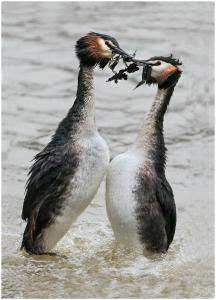
Richard Sharman ARPS finds joy in nature by studying and photographing its behaviour and actions. He does not totally eschew the portrait, but whilst illustrating the photographic beauty of some images he pointed out the absence of action. He contrasted a sedge warbler clinging to a reed with a pair of kingfishers sitting on a bank exchanging a fish. He watched for five minutes whilst the male tantalised the female with a fish until he finally surrendered it. It is vital to understand the species, its characteristics and behaviour he went on. He also emphasised that the technical rules of photography were really just tools. He argued for seeking out the expressive elements in an animal. For an owl it was its eyes. For a fox also the eyes demonstrate its evil intent. The decisive moment was also important to create emotion illustrating a coot defending its nest from a heron. As regards composition, he referenced Bruce Barnbaum with clarity of content, power of simplicity, mood, atmosphere and the absence of distraction as they key components. Understanding the species enabled gestalt theory to play a part if, through a sense of anticipation, the photographer foresees what the subject will do next. Two hours watching a bittern poking its head out of some reeds eventually paid off. He also encouraged using multiple images to illustrate action. They could be more powerful than a single image. He regretted the loss of wildlife habitat with examples of insects at Warnham Nature Reserve, butterflies at risk and voles with an impact on barn owls. He often illustrated the life cycle of particular species using macro photography and showed a number of examples.
